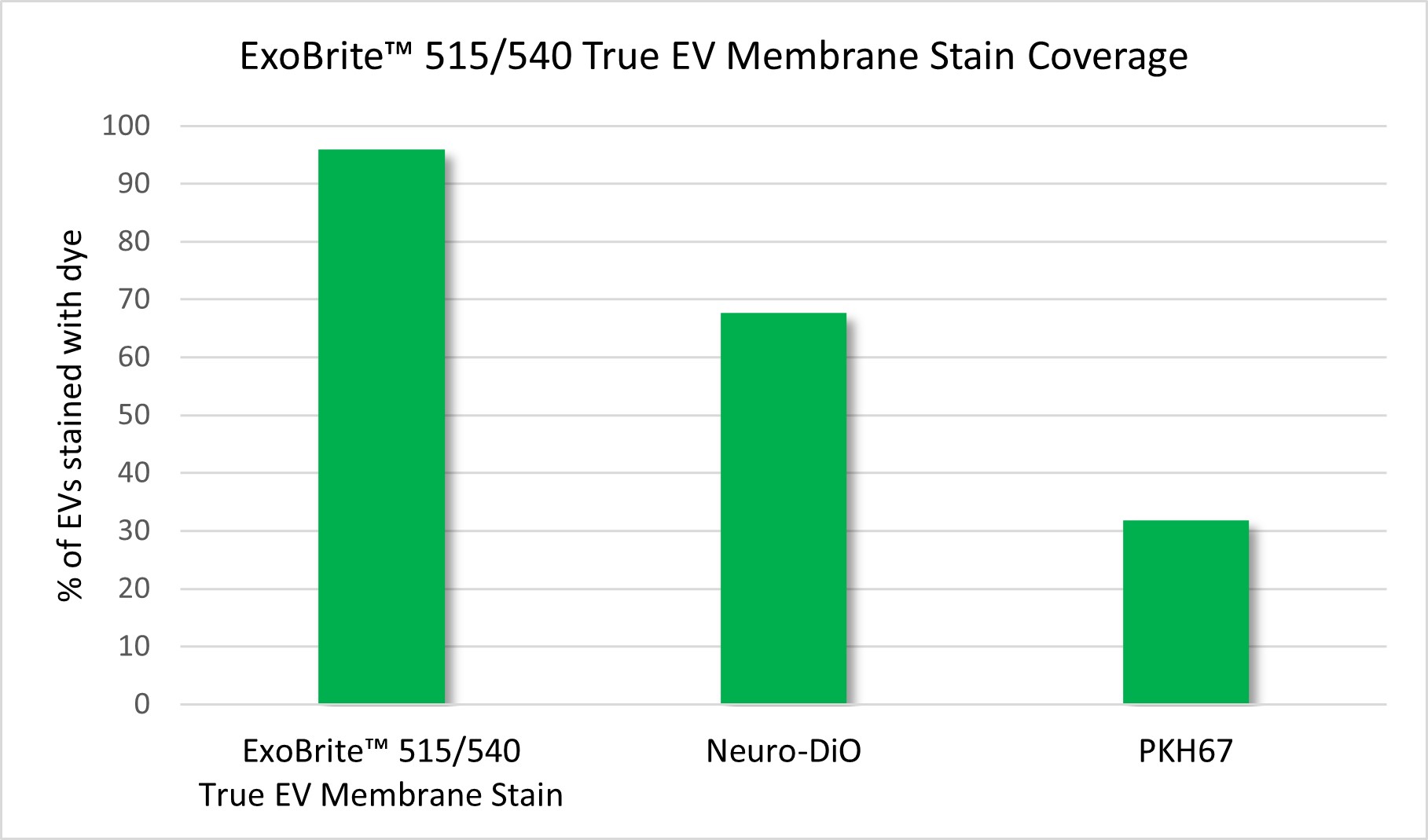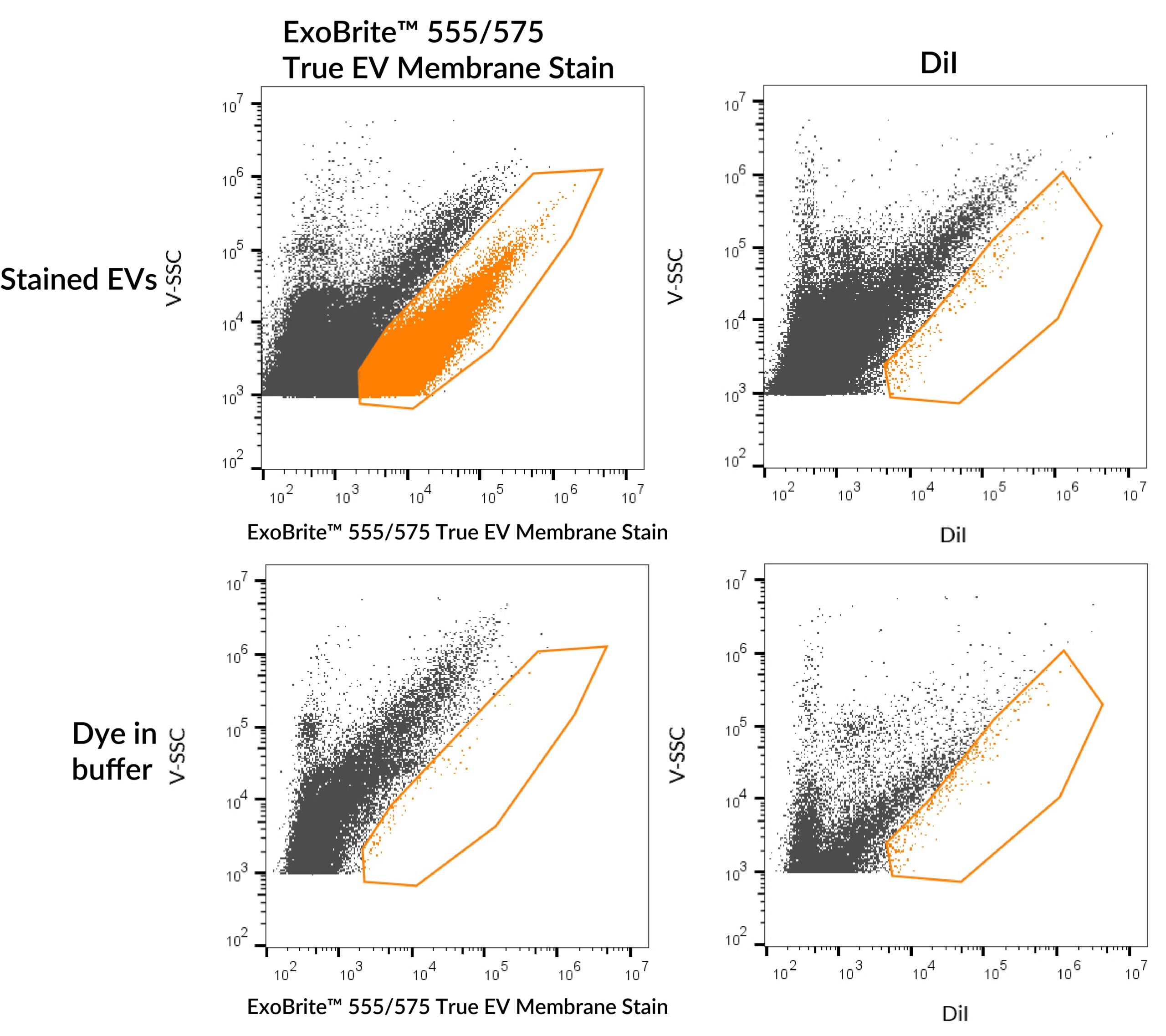ExoBrite™ True EV Membrane Stains
Lipophilic membrane dyes designed specifically for EV research and the best choice for general pan-EV staining. The dyes are validated to offer higher (near-complete) coverage of EVs with lower aggregation than other membrane dyes like PKH, DiO, and DiI.
Please fill in the inquiry form and we will contact you shortly.
Wishlist updated! View wishlist
Product Description
Elevate your EV research with ExoBrite™ True EV Membrane Stains. Offering unparalleled coverage and solubility, ExoBrite™ True EV Membrane Stains are genuine lipophilic membrane dyes that set a new standard in pan-EV labeling over classic dyes like PKH or DiO/DiI/DiD for EV staining.
Features
- Lipophilic membrane dyes designed for pan-EV labeling
- Superior alternative to common membrane dyes like PKH, DiO, DiI, DiD
- Near-complete coverage of EVs in a sample
- Broad compatibility with EVs isolated from different sources
- Compatible with antibody co-staining
- Available in 4 colors for Pacific Blue®, FITC, PE, and APC channels
- Validated on Particle Metrix ZetaView® and Spectradyne ARC™ Particle Analyzer
Detect EVs, not dye aggregates
Membrane dyes like PKH, DiO, and DiI, while common tools for labeling EVs, can pose significant challenges when used for EV staining. For example, membrane dyes often have poor solubility and thus form aggregates that can be confused with EVs. ExoBrite™ True EV Membrane Stains were designed specifically to address the issues of membrane dye aggregation while remaining a true lipophilic membrane stain for pan-EV labeling.
ExoBrite™ True EV Membrane Stains are the best choice for general pan-EV staining. They demonstrate higher (near-complete) coverage of EVs over competitor membrane dyes in fluorescence nanoparticle tracking analysis (fNTA). The dyes also offer clear differentiation of EVs from non-specific particles during flow detection. ExoBrite™ True EV Membrane Stains labeled all EV types tested to date (see Validated EV Sources below).
Note: We do not recommend using ExoBrite™ True EV Membrane Stains to stain bead-bound EVs. For bead-bound EVs we recommend using ExoBrite™ CTB EV Stains or ExoBrite™ WGA EV Stains.
Significantly Greater Coverage of EVs Over Other Membrane Dyes Such as PKH, DiO, and DiI


ExoBrite™ True EV Membrane Stain Outperforms PKH67
for EV Detection on ARC™ Particle Analyzer
In a collaboration between Biotium and Spectradyne, ExoBrite™ 515/540 True EV Membrane Stain and PKH67 were compared as membrane dyes for extracellular vesicles on the ARC™ Particle Analyzer. Results demonstrate ExoBrite™ 515/540 True EV Membrane Stain is more effective at staining EVs and is less susceptible to dye aggregation than PKH67 membrane dye.

Also view ExoBrite™ CTB, WGA, and Annexin EV Surface Stains
ExoBrite™ EV Surface Stains are fluorescent conjugates of probes for labeling EV membrane surface targets. The stains were designed to offer lower aggregation than competitor membrane dyes and are suitable for detecting bead-bound EVs, unlike ExoBrite™ True EV Membrane Stains and other hydrophobic membrane dyes. ExoBrite™ EV Surface Stains are available as cholera toxin subunit B (CTB), wheat germ agglutinin (WGA), or Annexin V conjugates. Biotium also offers a convenient ExoBrite™ EV Surface Stain Sampler Kit that includes each ExoBrite™ EV Surface Stains (CTB, WGA, and Annexin V) for assessing which stain offers the best coverage for the EV samples of interest.
Note: ExoBrite™ EV Stains have been found to label EVs derived from several tested cell lines (see Validated EV Sources below), but may not stain EVs from every source.
ExoBrite™ True EV Membrane Stains
| Product | Ex/Em | Detection Channels | Size | Catalog Number |
|---|---|---|---|---|
| ExoBrite™ 400/460 True EV Membrane Stain | 402/460 nm | Pacific Blue® | 100 Labelings | 30136-T |
| 500 Labelings | 30136 | |||
| ExoBrite™ 515/540 True EV Membrane Stain | 515/542 nm | FITC | 100 Labelings | 30129-T |
| 500 Labelings | 30129 | |||
| ExoBrite™ 555/575 True EV Membrane Stain | 556/576 nm | PE | 100 Labelings | 30130-T |
| 500 Labelings | 30130 | |||
| ExoBrite™ 645/675 True EV Membrane Stain | 644/671 nm | APC | 100 Labelings | 30137-T |
| 500 Labelings | 30137 |
Validated EV Sources for ExoBrite™ EV Surface Stains
| EV Source | ExoBrite™ True EV Membrane Stains | ExoBrite™ CTB Stains | ExoBrite™ WGA Stains | ExoBrite™ Annexin Stains |
|---|---|---|---|---|
| A549 cells | Yes | Yes | Yes | Yes |
| CHO cells | Yes | No | Yes | Yes |
| hASC (human adipose stem cells) | ND | No1 | ND | ND |
| HEK293T cells | ND | Yes1 | ND | ND |
| HeLa cells | Yes | No | Yes | Yes |
| HUVEC (human umbilical vein endothelial cells) | ND | No1 | ND | ND |
| J774 cells | Yes | Yes | Yes | Yes |
| Jurkat cells | Yes | Yes | Yes | Yes |
| MCF-7 cells | Yes | Yes | Yes | Yes |
| Plasma | ND | No | ND | Yes |
| Raji cells | ND | Yes | Yes | Yes |
| RAW 264.7 | Yes | ND | ND | ND |
| Serum | ND | No | ND | Yes |
| Skeletal myoblasts | ND | Yes1 | ND | ND |
| THP-1 | Yes | ND | ND | ND |
| U2OS cells | Yes | No | Yes | Yes |
| U937 cells | Yes | No | Yes | Yes |
Value of “Yes” or “No” indicates coverage of EVs based on Biotium’s internal data or customer-reported data. Value of “ND” indicates no data.
Biotium also offers other validated ExoBrite™ reagents for flow cytometry, western blotting, or super-resolution imaging.
Learn about ExoBrite™ Antibody Conjugates for optimal detection of CD9, CD63, and CD81 EV markers by flow cytometry and western blotting. For super-resolution imaging by STORM, learn about our ExoBrite™ STORM CTB EV Staining Kits available in four CF® Dyes validated for STORM.








